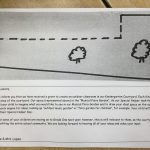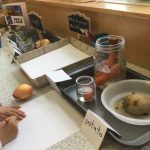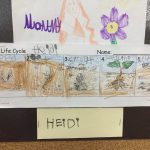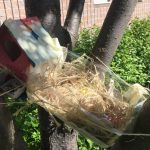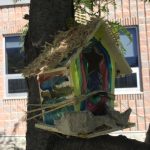Our project was the transformation of our kindergarten courtyard from a mostly concrete play space into a rich, green play-based learning environment stimulating meaningful inquiries for our students. We planned to develop a garden classroom where students could grow plants and vegetables and explore stimulating spaces, learning in all areas of the curriculum through games, observation, building and exploratory play. We hoped that the creation of an outdoor classroom would help us to develop a deeper pedagogical understanding of the learning environment as third teacher.
Team Members
Emma Greenslade
Peel District School Board
Karen Gutierrez/Leigh Hardcastle
Peel District School Board
Jennifer Darling/Juanna Chu
Peel District School Board
Pamela Lopes
Peel District School Board
Professional Learning Goals
In order to implement this project, the team has conducted a great deal of research about outdoor learning and garden classrooms online and through texts. We have had to examine the Kindergarten Program document closely, resulting in a much deeper understanding of outdoor learning and the environment as third teacher, and its value in the program. For example, we asked students to create a design, using an outline of one area of the courtyard, showing their dream music garden. This design addressed many areas of the curriculum. Drawing on the outline required spatial awareness and use of proportional reasoning. Communicating their ideas and reasoning, explaining how the various features work and could be made, as well as using the outline, involve Literacy and Belonging, and Contributing. A great deal of problem-solving and innovation was necessary in considering design and construction ideas and materials. Also, communicating their thoughts, feelings and ideas through various art forms addresses all four frames. This is to name but a few curriculum areas addressed by one small part of this project.
In preparation for the new space, our students have not only done research and begun planting and learning about how plants grow, they have also given input into what they would like to see in their outdoor learning area. The students came up with some wonderful ideas which we had not considered, such as building a stage. Giving them the opportunity to have input before creating the space has made them more invested in the project. We find that the students are able to use their imagination and limited experience to consider quite abstract ideas and inventions (e.g., determining the best materials for creating a drum or pan pipes and how to hold them in place). Although we already considered the students creative and capable, this project has shed new light on the scope of children’s ability to problem-solve, making connections with prior knowledge and their understanding of how the world works.
We have also experienced professional learning with regard to project management. In order to construct the learning space, it was necessary to revamp the courtyard. This required liaising with various board departments, such as Early Years, Sustainability and Maintenance. We discovered the wheels of bureaucracy run slowly and pressure needs to be put on the necessary departments early on in the process. Implementation was delayed due to a lack of shrub removal.
Activities and Resources
Initially, the team brainstormed potential activities for the students and listed necessary steps in order to accomplish our goals. We also divided up the responsibilities between the classes so that each had an area of focus. The team connected with Parent Council and local retailers, seeking donations to enrich the space. Parent Council has provided funds for a living willow structure and we have received discounts from various stores.
The students were involved in the design plans for the musical garden and the vegetable patch. They conducted research in order to decide what should be planted and how to maintain it. They have begun working on art projects to include in the outdoor classroom.
The teachers are preparing for the outdoor classroom by visiting local parks and woods, and either exploring outdoor learning there or bringing interesting discoveries and loose parts back to the indoor classroom for further exploration. We have completed class collages using natural materials found on walks, conducted math classes in the park using mats and natural materials, and read and re-enacted stories in the woods.
Resources:
A Place for Wonder: Reading and Writing Nonfiction in the Primary Grades by Georgia Heard and Jennifer McDonough
The Garden Classroom: Hands-On Activities in Math, Science, Literacy and Art by Cathy James
Imagine Childhood: Exploring the World Through Nature, Imagination, and Play by Sarah Olmsted
http://outdoor-classrooms.com – a website providing free online courses
Unexpected Challenges
The major challenge (soon to be resolved) has been the removal of the shrubs by the board. This is delaying the physical implementation of the project.
Enhancing Student Learning and Development
According to research and the curriculum, with the prevalence of electronic media today, children are experiencing a “nature deficit.” For children, being in nature allows them a freedom not experienced indoors, which sparks their natural curiosity and sense of wonder. Outdoor classrooms and outdoor learning “offer valuable learning opportunities and natural settings (that) can inspire the kind of thinking, learning, leadership and innovation that may be inhibited in children in the classroom but that, once revealed, can be incorporated back into the classroom environment.” (The Kindergarten Program, p. 34)
We as a team have found that our students are profoundly more engaged when the learning is taken outdoors. They are frequently initiating inquiries, and curiosity is everywhere and contagious. The students are enthusiastic about researching and recording their findings and presenting them to others (e.g., each other, other classes, or the school through bulletin boards or display cases). A class culture of wonder seems to have been created. In addition, behaviours have decreased as students are meaningfully engaged.
Sharing
We are sharing through discussion, documentation panels and presentations at staff meetings and kindergarten/Grade 1 professional development sessions. Also, we are contacting colleagues in the board who have expressed an interest in outdoor classrooms and are at varying stages of creating their own (via email). In addition, we are intending to share, once further along, via Twitter and the Ontario Kindergarten Teacher’s Facebook page.
Project Evaluation
So far the implementation of outdoor learning has been a success, as well as the inclusion of the students in the design process and initial research into which plants will work best in the garden. Student engagement is high and many curriculum expectations across all four frames are being met.
We look forward to being able to complete the project and reflect on its success when the space is transformed.
If we were to begin the project again, we would stress the urgency for shrub removal from the moment the application was approved.
Resources Used
A Place for Wonder: Reading and Writing Nonfiction in the Primary Grades by Georgia Heard and Jennifer McDonough
A wonderful and practical book inspiring teachers to tap into their students’ sense of wonder to enrich their teaching. Tried and tested in the implementation of inquiry programs.
The Garden Classroom: Hands-On Activities in Math, Science, Literacy and Art by Cathy James
Many inspiring ideas to use in an outdoor classroom. This is a text that is easy-to-use; it allows you to pick and choose easily, as descriptions of ideas are concise (limited to a page or two with eye-catching pictures which clearly model each idea).
Imagine Childhood: Exploring the World Through Nature, Imagination, and Play by Sarah Olmsted
This is a more in-depth look at the author’s experiences with the outdoors as a child. It is not as relevant or user-friendly.
A website which shows many different ideas for outdoor learning and features free e-courses through email.
Resources Created
These resources will open in your browser in a new tab, or be downloaded to your computer.



